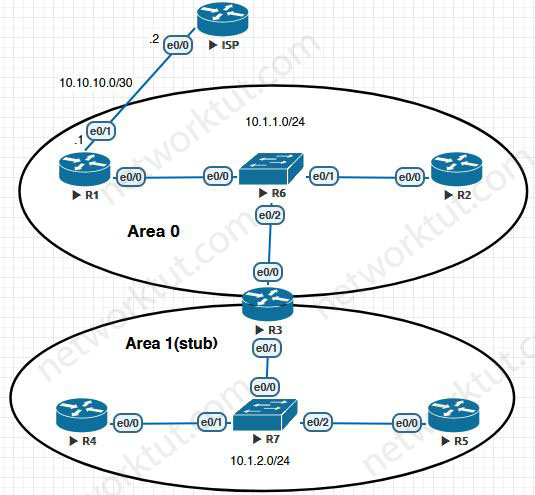OSPF Default-information originate and ABR
The purpose of this lab is to test if the default route generated by the “default-information originate” on R1 can be sent to the stub area (R4 & R5).
Topology

Note:
+ Each router Rn has one loopback interface n.n.n.n/32. R3 has two loopback interfaces: Lo0 in Area 0 and Lo1 in Area 1
+ The last octet of the IP address of each router is the same as the router number
Initial configs
|
R1 hostname R1 ! interface e0/0 ip address 10.1.1.1 255.255.255.0 no shut interface e0/1 ip address 10.10.10.1 255.255.255.252 no shut interface lo0 ip address 1.1.1.1 255.255.255.255 ! ip route 0.0.0.0 0.0.0.0 10.10.10.2 ! router ospf 1 network 10.1.1.1 0.0.0.0 area 0 network 1.1.1.1 0.0.0.0 area 0 |
R2 hostname R2 ! interface e0/0 ip address 10.1.1.2 255.255.255.0 no shut interface lo0 ip address 2.2.2.2 255.255.255.255 ! router ospf 1 network 10.1.1.2 0.0.0.0 area 0 network 2.2.2.2 0.0.0.0 area 0 |
R3 hostname R3 ! interface e0/0 ip address 10.1.1.3 255.255.255.0 no shut interface e0/1 ip address 10.1.2.3 255.255.255.0 no shut interface lo0 ip address 3.3.3.3 255.255.255.255 interface lo1 ip address 33.33.33.33 255.255.255.255 ! router ospf 1 network 10.1.1.3 0.0.0.0 area 0 network 3.3.3.3 0.0.0.0 area 0 network 10.1.2.3 0.0.0.0 area 1 network 33.33.33.33 0.0.0.0 area 1 |
|
R4 hostname R4 ! interface e0/0 ip address 10.1.2.4 255.255.255.0 no shut interface lo0 ip address 4.4.4.4 255.255.255.255 ! router ospf 1 network 10.1.2.4 0.0.0.0 area 1 network 4.4.4.4 0.0.0.0 area 1 |
R5 hostname R5 ! interface e0/0 ip address 10.1.2.5 255.255.255.0 no shut interface lo0 ip address 5.5.5.5 255.255.255.255 ! router ospf 1 network 10.1.2.5 0.0.0.0 area 1 network 5.5.5.5 0.0.0.0 area 1 |
ISP hostname ISP ! interface e0/0 ip address 10.10.10.2 255.255.255.252 no shut ! ip route 0.0.0.0 0.0.0.0 10.10.10.1 |
Everything works correctly and R3 (ABR) can see everyone:
R3#sh ip route ospf
--output omitted--
1.0.0.0/32 is subnetted, 1 subnets
O 1.1.1.1 [110/11] via 10.1.1.1, 00:11:43, Ethernet0/0
2.0.0.0/32 is subnetted, 1 subnets
O 2.2.2.2 [110/11] via 10.1.1.2, 00:11:33, Ethernet0/0
4.0.0.0/32 is subnetted, 1 subnets
O 4.4.4.4 [110/11] via 10.1.2.4, 00:11:00, Ethernet0/1
5.0.0.0/32 is subnetted, 1 subnets
O 5.5.5.5 [110/11] via 10.1.2.5, 00:10:50, Ethernet0/1
Configure Stub area
First we will configure Area 1 stub area. On R3, R4 and R5 we use the same commands:
On R3, R4, R5: router ospf 1 area 1 stub
R3 now generates a default route and advertise to R4 & R5:
R4#sh ip route ospf
--output omitted--
Gateway of last resort is 10.1.2.3 to network 0.0.0.0
O*IA 0.0.0.0/0 [110/11] via 10.1.2.3, 00:05:22, Ethernet0/0
1.0.0.0/32 is subnetted, 1 subnets
O IA 1.1.1.1 [110/21] via 10.1.2.3, 00:05:32, Ethernet0/0
2.0.0.0/32 is subnetted, 1 subnets
O IA 2.2.2.2 [110/21] via 10.1.2.3, 00:05:32, Ethernet0/0
3.0.0.0/32 is subnetted, 1 subnets
O IA 3.3.3.3 [110/11] via 10.1.2.3, 00:05:32, Ethernet0/0
5.0.0.0/32 is subnetted, 1 subnets
O 5.5.5.5 [110/11] via 10.1.2.5, 00:05:32, Ethernet0/0
10.0.0.0/8 is variably subnetted, 3 subnets, 2 masks
O IA 10.1.1.0/24 [110/20] via 10.1.2.3, 00:05:32, Ethernet0/0
33.0.0.0/32 is subnetted, 1 subnets
O 33.33.33.33 [110/11] via 10.1.2.3, 00:05:32, Ethernet0/0
This is a Type 3 LSA (Summary Net Link States):
R4#show ip ospf database
OSPF Router with ID (10.1.2.4) (Process ID 1)
Router Link States (Area 1)
Link ID ADV Router Age Seq# Checksum Link count
10.1.2.3 10.1.2.3 191 0x8000000C 0x0093B4 2
10.1.2.4 10.1.2.4 193 0x8000000B 0x00BEFC 2
10.1.2.5 10.1.2.5 378 0x80000009 0x00EEC7 2
Net Link States (Area 1)
Link ID ADV Router Age Seq# Checksum
10.1.2.5 10.1.2.5 373 0x80000007 0x00B624
Summary Net Link States (Area 1)
Link ID ADV Router Age Seq# Checksum
0.0.0.0 10.1.2.3 389 0x80000001 0x002FFE
1.1.1.1 10.1.2.3 389 0x80000002 0x0063BB
2.2.2.2 10.1.2.3 389 0x80000002 0x0035E5
3.3.3.3 10.1.2.3 389 0x80000002 0x00A27E
10.1.1.0 10.1.2.3 389 0x80000003 0x00EB2B
With this default route, R4 can ping R1 loopback0 (1.1.1.1):
R4#ping 1.1.1.1 Type escape sequence to abort. Sending 5, 100-byte ICMP Echos to 1.1.1.1, timeout is 2 seconds: !!!!!
Turn on “default-information originate” command
Now let’s see what will happen when we use the “default-information originate” command on R1 to advertise a default route to its downstream routers:
R1: router ospf 1 default-information originate
Let’s check the OSPF topology on R3:
R3#sh ip ospf database
OSPF Router with ID (10.1.2.3) (Process ID 1)
Router Link States (Area 0)
Link ID ADV Router Age Seq# Checksum Link count
10.1.1.1 10.1.1.1 134 0x80000009 0x00DDF6 2
10.1.1.2 10.1.1.2 1806 0x80000008 0x0006CA 2
10.1.2.3 10.1.2.3 1787 0x80000007 0x0025A2 2
Net Link States (Area 0)
Link ID ADV Router Age Seq# Checksum
10.1.1.3 10.1.2.3 1048 0x80000006 0x005393
Summary Net Link States (Area 0)
Link ID ADV Router Age Seq# Checksum
4.4.4.4 10.1.2.3 40 0x80000002 0x00BA56
5.5.5.5 10.1.2.3 1014 0x80000001 0x008E7F
10.1.2.0 10.1.2.3 1787 0x80000004 0x00C052
33.33.33.33 10.1.2.3 40 0x80000002 0x001B8B
Router Link States (Area 1)
Link ID ADV Router Age Seq# Checksum Link count
10.1.2.3 10.1.2.3 835 0x8000000C 0x0093B4 2
10.1.2.4 10.1.2.4 839 0x8000000B 0x00BEFC 2
10.1.2.5 10.1.2.5 1023 0x80000009 0x00EEC7 2
Net Link States (Area 1)
Link ID ADV Router Age Seq# Checksum
10.1.2.5 10.1.2.5 1018 0x80000007 0x00B624
Summary Net Link States (Area 1)
Link ID ADV Router Age Seq# Checksum
0.0.0.0 10.1.2.3 1034 0x80000001 0x002FFE
1.1.1.1 10.1.2.3 1034 0x80000002 0x0063BB
2.2.2.2 10.1.2.3 1034 0x80000002 0x0035E5
3.3.3.3 10.1.2.3 1034 0x80000002 0x00A27E
10.1.1.0 10.1.2.3 1034 0x80000003 0x00EB2B
Type-5 AS External Link States
Link ID ADV Router Age Seq# Checksum Tag
0.0.0.0 10.1.1.1 135 0x80000001 0x00CBD9 1
We see R3 received a Type 5 LSA from R1, which is the default route generated via the “default-information originate” command above.
The routing table of R3 now has this default route:
R3#sh ip route ospf
--output omitted--
Gateway of last resort is 10.1.1.1 to network 0.0.0.0
O*E2 0.0.0.0/0 [110/1] via 10.1.1.1, 00:03:41, Ethernet0/0
1.0.0.0/32 is subnetted, 1 subnets
O 1.1.1.1 [110/11] via 10.1.1.1, 00:18:47, Ethernet0/0
2.0.0.0/32 is subnetted, 1 subnets
O 2.2.2.2 [110/11] via 10.1.1.2, 00:18:47, Ethernet0/0
4.0.0.0/32 is subnetted, 1 subnets
O 4.4.4.4 [110/11] via 10.1.2.4, 00:18:47, Ethernet0/1
5.0.0.0/32 is subnetted, 1 subnets
O 5.5.5.5 [110/11] via 10.1.2.5, 00:18:27, Ethernet0/1
How about R4 & R5? Let’s check its OSPF database:
R4#sh ip ospf database
OSPF Router with ID (10.1.2.4) (Process ID 1)
Router Link States (Area 1)
Link ID ADV Router Age Seq# Checksum Link count
10.1.2.3 10.1.2.3 1112 0x8000000C 0x0093B4 2
10.1.2.4 10.1.2.4 1114 0x8000000B 0x00BEFC 2
10.1.2.5 10.1.2.5 1299 0x80000009 0x00EEC7 2
Net Link States (Area 1)
Link ID ADV Router Age Seq# Checksum
10.1.2.5 10.1.2.5 1294 0x80000007 0x00B624
Summary Net Link States (Area 1)
Link ID ADV Router Age Seq# Checksum
0.0.0.0 10.1.2.3 1311 0x80000001 0x002FFE
1.1.1.1 10.1.2.3 1311 0x80000002 0x0063BB
2.2.2.2 10.1.2.3 1311 0x80000002 0x0035E5
3.3.3.3 10.1.2.3 1311 0x80000002 0x00A27E
10.1.1.0 10.1.2.3 1311 0x80000003 0x00EB2B
We can see the Type 5 LSA has been blocked from entering stub area so the OSPF database of R4 remains unchanged.
The routing table of R4 remains unchanged:
R4#show ip route ospf
Codes: L - local, C - connected, S - static, R - RIP, M - mobile, B - BGP
D - EIGRP, EX - EIGRP external, O - OSPF, IA - OSPF inter area
N1 - OSPF NSSA external type 1, N2 - OSPF NSSA external type 2
E1 - OSPF external type 1, E2 - OSPF external type 2
i - IS-IS, su - IS-IS summary, L1 - IS-IS level-1, L2 - IS-IS level-2
ia - IS-IS inter area, * - candidate default, U - per-user static route
o - ODR, P - periodic downloaded static route, H - NHRP, l - LISP
a - application route
+ - replicated route, % - next hop override
Gateway of last resort is 10.1.2.3 to network 0.0.0.0
O*IA 0.0.0.0/0 [110/11] via 10.1.2.3, 00:32:51, Ethernet0/0
1.0.0.0/32 is subnetted, 1 subnets
O IA 1.1.1.1 [110/21] via 10.1.2.3, 00:33:01, Ethernet0/0
2.0.0.0/32 is subnetted, 1 subnets
O IA 2.2.2.2 [110/21] via 10.1.2.3, 00:33:01, Ethernet0/0
3.0.0.0/32 is subnetted, 1 subnets
O IA 3.3.3.3 [110/11] via 10.1.2.3, 00:33:01, Ethernet0/0
5.0.0.0/32 is subnetted, 1 subnets
O 5.5.5.5 [110/11] via 10.1.2.5, 00:33:01, Ethernet0/0
10.0.0.0/8 is variably subnetted, 3 subnets, 2 masks
O IA 10.1.1.0/24 [110/20] via 10.1.2.3, 00:33:01, Ethernet0/0
33.0.0.0/32 is subnetted, 1 subnets
O 33.33.33.33 [110/11] via 10.1.2.3, 00:33:01, Ethernet0/0
Summary
The default route generated and forwarded via the “default-information originate” command is a Type 5 LSA and it is blocked by the ABR of the Stub area. In the table below, it is shown by “Type 5 LSA” column and “Stub Area” row:



